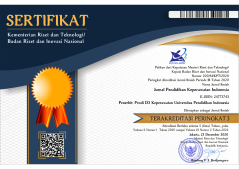Perbandingan Hematoma Pasca Kateterisasi Jantung Berdasarkan Penekanan Bantal Pasir dan Cold Pack
Abstract
ABSTRAK
Kateterisasi jantung merupakan prosedur untuk mendiagnosis dan/atau mengevaluasi arteri koroner. Pada akhir prosedur, dilakukan pelepasan femoral sheath dan penekanan manual maupun mekanik pada arteri femoralis untuk mengontrol perdarahan hingga tercapai hemostasis. Teknik penekanan yang tidak adekuat pada sisi akses arteri setelah kateterisasi jantung merupakan salah satu penyebab terjadinya hematoma. Ditemukan kejadian hematoma pada pasien pasca kateterisasi jantung yang timbul beberapa waktu setelah penekanan mekanik bantal pasir. Penelitian ini bertujuan untuk membandingkan ukuran hematoma dalam waktu 24 jam pasca kateterisasi jantung berdasarkan penekanan mekanik bantal pasir dan cold pack. Penelitian ini merupakan penelitian komparatif dengan pendekatan after-only non-equivalent control group design. Subjek penelitian adalah 20 orang pasien pasca kateterisasi jantung yang dibagi menjadi kelompok eksperimen dengan penekanan mekanik cold pack selama 20 menit setelah pelepasan femoral sheath dan kelompok kontrol dengan penekanan mekanik bantal pasir 2,5 Kg selama 6 jam setelah pelepasan femoral sheath. Kejadian hematoma dilihat setelah penekanan manual, penekanan mekanik, dan setiap jam selama 24 jam. Perbedaan kejadian hematoma dilihat dengan menggunakan uji Mann-Whitney. Hasil penelitian menunjukkan bahwa tidak terdapat perbedaan bermakna ukuran hematoma setelah penekanan manual, penekanan mekanik dan setiap jam dalam waktu 24 jam pada pasien pasca kateterisasi jantung yang menggunakan bantal pasir maupun cold pack (ρ > 0,05). Pada kelompok eksperimen ukuran hematoma mengecil di akhir jam ke-24 dan pada kelompok kontrol ukuran hematoma membesar di akhir jam ke-24. Penggunaan penekanan mekanik cold pack dapat mengurangi risiko hematoma sebagaimana bantal pasir, sehingga cold pack dapat digunakan sebagai pilihan alat tekan mekanik pada pasien pasca kateterisasi jantung.
ABSTRACT
Cardiac catheterization is a procedure to diagnose and/or evaluate coronary arteries. At the end of procedure, performed manual and mechanical compression on the femoral artery to control bleeding until homeostasis is achieved. Inadequate compression techniques on the arterial access after cardiac catheterization is one of the causes of hematoma. Found in hematoma incidence in patients after cardiac cathetherization that arise after mechanical compression using sandbags. The purpose of this study was to compare the size of the hematoma within 24 hours after cardiac catheterization using sandbags and cold pack mechanical compression. The study design was a comparative study with after-only non-equivalent control group design. Research subjects included of 20 after cardiac catheterization patients were divided into an experimental group with cold pack mechanical compression for 20 minutes after femoral sheath release and control group with sandbags mechanical compression for 6 hours after femoral sheath release. Incidence of hematoma was observed after manual compression, mechanical compression, and every hour for 24 hours. Mann-Whitney test was used to see the difference the incidence of hematoma of both of groups. The results showed no significant difference in the size of the hematoma after manual compression, mechanical compression, and every hour within 24 hours after cardiac catheterization in both of groups (ρ> 0.05). But the size of the hematoma in the end of observation time was smaller in experiment group, and bigger in the control group. The use ofcold pack mechanical compressions could reduce the risk of hematoma as well as sandbags. Thus, cold pack could be used as an alternative mechanical compression tool in patients with post cardiac catheterization.
Keywords
Full Text:
PDFReferences
Argulian, E., Patel, A. D., Abramson, J. L., Kulkarni, A., Champney, K.,
Palmer, S., Weintraub, W., et al. (2006). Gender Differences in Short-Term Cardiovascular Outcomes After Percutaneous Coronary Interventions. Journal of the American College of Cardiology, 48-53. doi:10.1016/j.amjcard.2006.01.048
Christensen, B, Lacarella, C., Manion, R., Bruhn-Ding, B., Meyer, S., & Wilson, R. (1994). Sanbags do not prevent complications after catheterization. Circulation, 90, 1-205.
Christensen, BV, Manion, R., Lacarella, C., Meyer, S., Cartland, J., & Bruhn-
Ding, B. (1998). Vascular complications after angioraphy with and without the use of sandbags. Nurs Res, 47, 51-3.
Cushman, M. (2002). Effects of hormone replacement therapy and estrogen receptor modulators on markers of inflammation and coagulation. Am J Cardiol, 90(suppl), 7F-10F.
Direktorat Jenderal PP & PL RI. (2009). Profil Pengendalian Penyakit & Penyehatan Lingkungan Tahun 2008.
Grossman, W., & Baim, D. S. (2006). Cardiac Catheterization, Angiography, and Intervention (7th Edition). (Donal S Baim, Ed.) (7th ed.). Lippincott Williams & Wilkins.
Guyton, A. C., & Hall, J. E. (1997). Textbook of Medical Physiology, 9th Edition. Saunders Company. Philadelphia, Pennsylvania.
Jones, T., & Mccutcheon, H. (2002). Effectiveness of Mechanical Compression Devices in Attaining Hemostasis After Femoral Sheath Removal. American Journal Of Critical Care, 11, 155-162.
Juran, N., Rouse, C. L., Deborah, D., O’Brien, M. A., DeLuca, S. A., & Sigmon, K. (1999). Nursing interventions to decrease bleeding at the femoral access site after percutaneous coronary intervention. American Journal Of Critical Care, 8, 303-13.
Kern, M. J., Cohen, M., Talley, J. D., Litvack, F., Serota, H., Aguirre, F., Deligonul, U., et al. (1990). Early ambulation after 5 french diagnostic cardiac catheterization: results of a multicenter trial. Journal Americal College of Cardiology, 15(7), 1475-83.
King, N. a, Philpott, S. J., & Leary, A. (2008). A randomized controlled trial assessing the use of compression versus vasoconstriction in the treatment of femoral hematoma occurring after percutaneous coronary intervention. Heart & lung : the journal of critical care, 37(3), 205-10. doi:10.1016/j.hrtlng.2007.05.008
Lins, S., Guffey, D., Vanriper, S., & Kline-rogers, E. (2006). Decreasing Vascular Complications After Percutaneous Coronary Interventions : Partnering to Improve Outcomes. Critical Care Nurse, (26), 38-45.
Losordo, D., Kearney, M., Kim, E., Jekanowski, J., & Isner, J. (1994). Variable expression of the estrogen receptor in normal and atherosclerotic coronary arteries of premenopausal women. Circulation, 89, 1501-1510.
Lundin, L., Sargent, T., & Burke, L. (1998). Research utilization and improvement in outcomes after diagnostic cardiac catheterization. Critical care nurse, 18(5), 30-1, 34-9. Retrieved from http://www.ncbi.nlm.nih.gov/pubmed/9934047
Miller, V., Lewis, D., & Barber, D. (1999). Gender differences and endothelium- and platelet-derived factors in the coronary circulation. Clin Exp Pharmacol Physiol, 26, 132-136.
Manik, M. J. (2012). Perbedaan Penekanan Mekanik Bantal Pasir Durasi 1 jam dengan Cold-Pack Durasi 20 menit terhadap Insiden Komplikasi Vaskuler Lokal dan Neuropati Femoral Pasca Kateterisasi Jantung. Padjadjaran University.
Osborn, K. S., Wraa, C. E., & Watson, A. B. (2010). Medical-surgical nursing preparation for practice volume 1 (p. 1129). United States of America: Pearson.
Patients Safety Advisory. (2007). Strategies to Minimize Vascular Complications following a Cardiac Catheterization. PA-PSRS Patient Safety Advisory, 4(2), 1-8.
Rosendaal, F., Helmerhorst, F., & Vandenbroucke, J. (2002). Female hormones and thrombosis. Arterioscler Thromb Vasc Biol, 22, 201-210.
Rubanyi, G., Johns, A., & Kauser, K. (2002). Effect of estrogen on endothelial function and angiogenesis. Vasc Pharmacol, 38, 89-98.
Shoulders-odom, B. (2008). Management of Patients After Percutaneous Coronary Interventions. Critical Care Nurse, 28(5), 26-40.
Supriyono, M. (2008). Faktor-faktor risiko yang berpengaruh terhadap kejadian penyakit jantung koroner pada kelompok usia <= 45 tahun. Universitas Diponegoro.
Simon, A., Bumgarner, B., Clark, K., & Israel, S. (1998). Manual versus mechanical compression for femoral artery hemostasis after cardiac catheterization. American Journal Of Critical Care, 7(4), 308.
Yilmaz, E., Gurgun, C., & Dramali, A. (2007). Minimizing short-term complications in patients who have undergone cardiac invasive procedure: a randomized controlled trial involving position change and sandbag. Anadolu kardiyoloji dergisi : AKD = the Anatolian journal of cardiology, 7, 390-6. Retrieved from http://www.ncbi.nlm.nih.gov/pubmed/18258546
Ying, S., Mba, R. N., Fernandez, R., Mn, R. N., Lui, M. H.-lin, Mphil, R. N., Lopez, V., et al. (2008). The clinical effectiveness of length of bed rest for patients recovering from trans-femoral diagnostic cardiac catheterisation. Int J Evid Based Health, 352-390. doi:10.1111/j.1479-6988.2008.00111.x
Wnorowsky. (2011). Heat and Cold Therapy. Retrieved from http://genufix.com/heat_and_cold_therapy.htm
Woods, S. L., Froelicher, E. S. S., Motzer, S. U., & Bridges, E. J. (2010). Cardiac Nursing, Sixth Edition. Wolters Kluwer Health, Lippincott Williams & Wilkins.
World Health Report. (2004). The World Health Report 2004 changing history. World Health Organization
DOI: https://doi.org/10.17509/jpki.v3i2.9414
Refbacks
- There are currently no refbacks.
Jurnal Pendidikan Keperawatan Indonesia(JPKI) published by Indonesia University of Education. JPKI is licensed under a Creative Commons Attribution-ShareAlike 4.0 International License.
Office :
Nursing Department. FPOK UPI.
229, Dr. Setiabudhi Street. Bandung 40154
West Java , Indonesia
E-mail : jpki@upi.edu

_.png)
_.png)
_.png)











